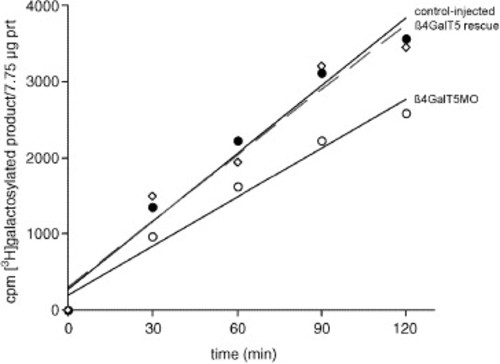Fig. 4
- ID
- ZDB-FIG-071001-12
- Publication
- Machingo et al., 2006 - A beta1,4-galactosyltransferase is required for convergent extension movements in zebrafish
- Other Figures
- All Figure Page
- Back to All Figure Page
|
Reduced galactosyltransferase activity in β4GalT1 morphant embryos. Lysates of control-injected (•), morpholino-injected (&Omicron), and morpholino + β4GalT1 mRNA injected (i.e., rescued) (Ê) embryos were assayed for galactosyltransferase activity towards N-acetylglucosamine (GlcNAc). A 30% reduction in activity is seen in lysates from morphant embryos (moderate phenotype at 18 somite stage), relative to lysates from control-injected embryos. Results are representative of three independent assays (two MO1, one MO2). Co-injection of mRNA encoding the catalytic domain of zebrafish β4GalT1 along with MO2 rescued the morphant phenotype (Fig. 3) and brought galactosyltransferase activity back to control levels. The relative decrease in activity (∼30%) should not be taken as an indication of the relative contribution of β4GalT1 to the total repertoire of zebrafish galactosyltransferases, since residual β4GalT1 transcripts likely remain and the relative affinity of the different β4GalT isoforms towards GlcNAc is unknown. |
Reprinted from Developmental Biology, 297(2), Machingo, Q.J., Fritz, A., and Shur, B.D., A beta1,4-galactosyltransferase is required for convergent extension movements in zebrafish, 471-482, Copyright (2006) with permission from Elsevier. Full text @ Dev. Biol.

